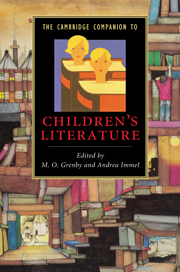9 - Gender roles in children’s fiction
from Part II - Audiences
Published online by Cambridge University Press: 28 November 2010
Summary
Girlhood and boyhood, at least until quite recently, have often been treated as separate, different and unequal in children's literature. Eighteenth-, nineteenth- and twentieth-century children's books are full of strong, active boy characters, and much more submissive, domestic and introspective girls. But equally prevalent, even if sometimes less immediately obvious, has been a recurrent expression of the flimsiness and artificiality of the division between boys and girls, and of the desire of many protagonists to contravene the gender identities enjoined on them. Many favourite characters from children's books either long to defy the simple gender categorisation imposed on them as members of the Anglo-American middle classes, or actually actively transgress the roles assigned to them. Here, for instance, is Georgina, speaking out in the first of Enid Blyton's Famous Five books:
'I'm George', said the girl. 'I shall only answer if you call me George. I hate being a girl. I won't be. I don't like doing the things that girls do. I like doing the things that boys do. I can climb better than any boy, and swim faster too. I can sail a boat as well as any fisher-boy on the coast. You're to call me George. Then I'll speak to you. But I shan't if you don't.'
George epitomises both the sharp division between the social construction of girls and boys and the longing to cross the divide. Wearing shorts, with cropped curly hair and refusing to answer to her given name, this dogged eleven-year-old is determined to dodge the female role in which biology has cast her.
- Type
- Chapter
- Information
- The Cambridge Companion to Children's Literature , pp. 143 - 158Publisher: Cambridge University PressPrint publication year: 2009
- 3
- Cited by

